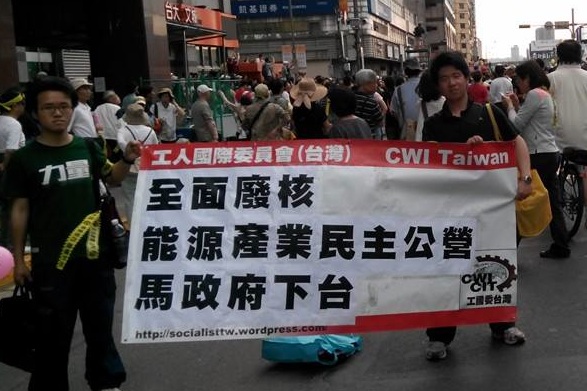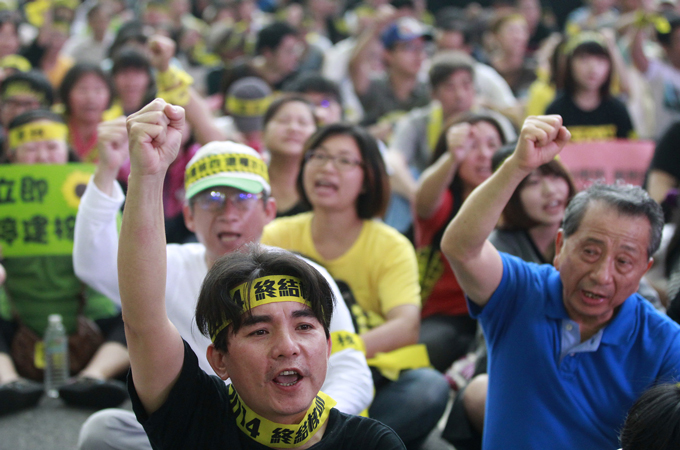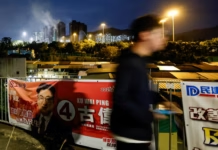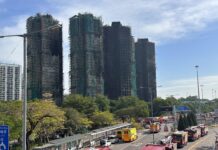Echoes of ‘sunflower movement’ as thousands stage ‘occupy’ protests in Taipei
CWI Taiwan reporters
There seems to be no respite for Taiwan’s beleaguered president Ma Ying-jeou. Tens of thousands of people took part in a two-day protest in Taipei at the weekend to demand the government cancel its planned fourth nuclear power plant, known as “Nuke 4” to Taiwanese. A former chairman of the opposition Democratic Progressive Party (DPP) Lin Yi-hsiung began a hunger strike on April 22, which has further heightened emotions over the plant’s continued construction. Even torrential rain on Sunday could not deter the protesters, who are planning to occupy a section of main road near the Executive Yuan. Solidarity demonstrations and sit-in protests were also held in southern and northern Taiwan over the weekend.
“The demonstration orgnanisers say they will continue indefinitely after police blocked some roads including the main march route,” said Sally Tang Mei-ching of the Committee for a Workers’ International (CWI) in Taipei.
“There is big anger against Ma and the ruling Kuomintang (KMT) over this issue. A few days ago protesters tried to stop the car of a KMT legislator, but the car didn’t slowdown, which was very dangerous. Film of this incident has gone viral on social media,” she reported.
President Ma offered concessions on Friday in talks with DPP leaders, putting the plant’s start-up on hold to allow a referendum. But this is not enough to defuse the anger of Taiwan’s anti-nuclear movement, which has staged massive protests in recent years including a protest of more than 200,000 people last year. The threshold for a successful ‘yes’ vote – in this case to abolish ‘Nuke 4’ – is notoriously hard to obtain under Taiwan’s “archaic” referendum rules. These state that at least 50 percent of eligible voters must vote, and to win a proposition must get at least 50 percent of ballots cast. The rules leave plenty of scope for manipulation by government to defeat its opponents on ‘technical’ grounds.
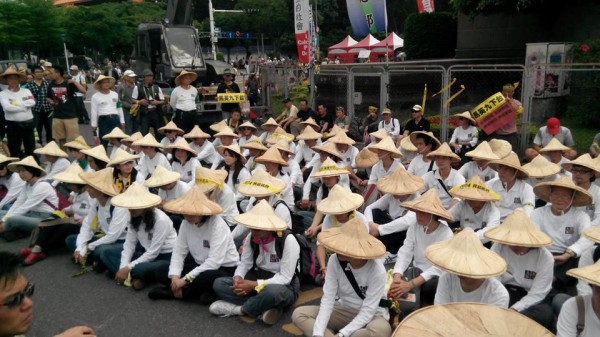
Nuclear threat
The 283 billion TWD (US$9.3 billion) ‘Nuke 4’ project was first proposed in 1980 and has been beset by protests from the start. Construction started in 2009 during president Ma’s first term. Objections to the plant range from the high cost to technical and safety issues – given its location just 42 kilometres from Taipei. These concerns soared in the aftermath of the 2011 Fukushima disaster – both Japan and Taiwan are highly prone to earthquakes. If a similar disaster should befall the ‘Nuke 4’ plant, a metropolitan area of nearly seven million people would need to be evacuated.
The latest upsurge of the anti-nuke movement in Taiwan is clearly shaped and influenced by the ideas and methods of the recent ‘sunflower’ protest movement. Opposition to Ma and the KMT government is sky high, and many are frustrated the previous mass protests did not inflict a decisive defeat on the government and its unpopular trade pact (CSSTA).
“There are many ‘Down with Ma’ placards at today’s demo,” said Sally Tang Mei-ching. “The CWI branch in Taiwan are campaigning around the demand for the total abolition of nuclear power – we favour big investment to develop safe and renewable energy such as solar, wind and wave power. For that to happen, the energy industry would have to be controlled and owned democratically, instead of by state officials and the stock market, which is the case today. We think the anti-nuclear movement needs to link up with the workers’ movement, students and other layers to reignite the mass protests of last month, but this time to kick Ma out of office!”
The CWI is present in the ongoing anti-nuclear protests and can be reached on 0983 252 840.
